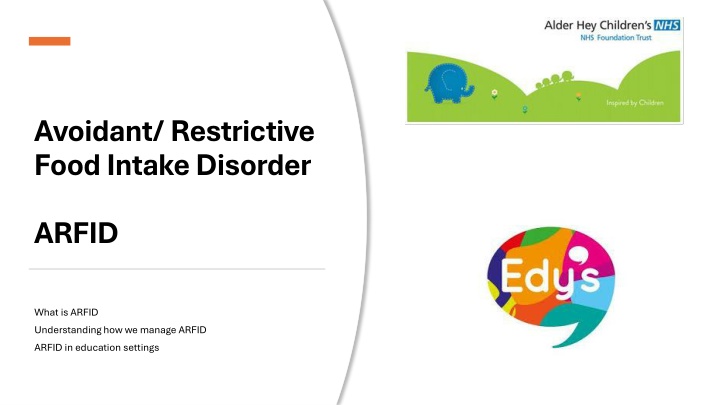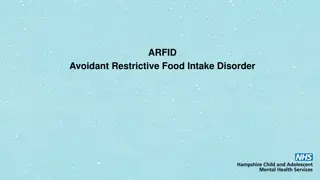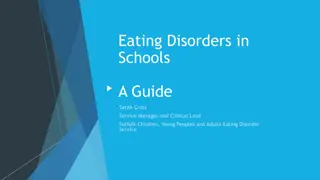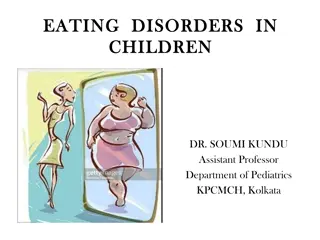
ARFID and Management Strategies in Education Settings
Discover what Avoidant/Restrictive Food Intake Disorder (ARFID) is, how it is managed, its impact in education settings, and the importance of developing ARFID pathways for children and young people. Gain insights from specialists and initiatives in addressing ARFID within mental health services.
Download Presentation

Please find below an Image/Link to download the presentation.
The content on the website is provided AS IS for your information and personal use only. It may not be sold, licensed, or shared on other websites without obtaining consent from the author. If you encounter any issues during the download, it is possible that the publisher has removed the file from their server.
You are allowed to download the files provided on this website for personal or commercial use, subject to the condition that they are used lawfully. All files are the property of their respective owners.
The content on the website is provided AS IS for your information and personal use only. It may not be sold, licensed, or shared on other websites without obtaining consent from the author.
E N D
Presentation Transcript
Avoidant/ Restrictive Food Intake Disorder ARFID What is ARFID Understanding how we manage ARFID ARFID in education settings
Welcome Emily Conway Specialist Mental Health Practitioner CBT Therapist ARFID Lead, EDYS
Alder Hey Eating Disorder Service for Young People Dedicated community- based service Established in 2015 following new National funding (AWT) For children and young people(CYP) up to the age of 18 Speech and Language Therapist Assistant Psychologists Support Worker Multidisciplinary team: Psychology Psychiatry Paediatrics Mental Health Nurses Family Therapists Dietetics Occupational Therapist
Why develop an ARFID pathway? The Long-Term Plan in 2019 allocated an additional 11m funding for CYP community eating disorder services This included an expectation that services develop ARFID pathways Longstanding gap in services for CYP with ARFID Pathway development delayed within EDYS due to the unprecedented increase in eating disorder presentations during the COVID-19 Pandemic However, further expansion of the service, and a levelling off of the rise in referrals, means that the development of the ARFID pathway has been possible
What are peoples experiences of ARFID? Have people worked with any CYP with a diagnosis? Any thoughts to share before we start?
What is ARFID What is ARFID Avoidant Restrictive food intake Avoidant Restrictive food intake disorder? disorder? APPARENT LACK APPARENT LACK OF INTEREST IN OF INTEREST IN EATING EATING 1)Significant weight loss (or failure to gain weight or faltering growth in children) 2) Significant nutritional deficiency FOOD AVOIDANCE FOOD AVOIDANCE BASED ON SENSORY BASED ON SENSORY CHARACTERISTICS CHARACTERISTICS OF FOOD OF FOOD 3) Dependence on oral/enteral feeding 4) Marked interference with psychosocial functioning CONCERN ABOUT CONCERN ABOUT AVERSIVE AVERSIVE CONSEQUENCES CONSEQUENCES OF EATING/ FEAR OF EATING/ FEAR
Significant Significant Psychosocial Psychosocial impact impact Unable to attend school/ very poor attendance Dependence on Dependence on enteral/ oral enteral/ oral feeding feeding Does the young person have supplement prescribed, and is able to take them? Risks if CYP was not taking the supplement drinks NGT/ PEG feeding Significant Significant nutritional nutritional deficiency deficiency The CYP has significant nutritional deficiencies that require treatment Is the CYP taking a multivitamin? Weight/ Growth Weight/ Growth Significant loss of weight Difficulties leaving the house Failure to gain weight (when required) Faltering growth Unable to go out for family days out i.e. nothing to eat when you get there/ struggle to cope with smells Some insufficiencies can be expected (e.g. Vit D) most young people would have this Low iron can be managed in Primary Care (GP)
What ARFID is not: Problems with weight that are related to body and shape concerns Feeding problems that are related to scarcity of foods or any religion that has specific rules around food Related to any medical or psychiatric condition (i.e. depression that might leads to reduce food intake and consequently weight loss).
Who can have ARFID? Who can have ARFID? Who can have ARFID? Anyone of any age can have ARFID People with ARFID can be any weight ARFID can be long-term or come on suddenly ARFID often co-occurs with autism, ADHD, or other learning difficulties
Spectrum of eating difficulties There is a spectrum of disordered eating in children: SENSORY PROCESSING DISORDER (SPD) Mild disordered eating Moderate disordered eating Severe disordered eating AVOIDANT RESTRICTIVE INTAKE DISORDER (ARFID) Refusal of several foods & some mealtime disruption Dislike of food categories (e.g. texture/colour) Dislike of most foods (texture/colour) Dislike of a single food -Growth faltering can occur -Micronutrient deficiencies common -Significant weight loss (or failure to achieve expected weight gain/faltering growth in children -Significant nutritional deficiency -Dependence on oral nutritional supplements or tube feeding -Marked interference with psychosocial functioning -Usually normal growth -Possible micronutrient deficiencies
ARFID and other comorbidities ASD ASD Some common dietary considerations for CYP with ASD are: Some common dietary considerations for CYP with ASD are: A need for routine around mealtimes. This can include specific seating for you and the people you eat with, or specific cutlery and plates. Sensitivity to smells, sights and sound at mealtimes can impact eating Gut upset, including constipation, diarrhoea and a bloated stomach Food hypersensitivity (when the body reacts badly to certain foods) Eating a limited diet - a small number of foods similar in colour and taste H How much of an overlap does autism have with ARFID? ow much of an overlap does autism have with ARFID? Current research recognises that autism is seen in those with ARFID at higher rates than the general population rate of 1.5%. Estimates of co-occurring ARFID and ASD range from 12.5% all the way up to 33.3%. Many people with autism experience sensory issues/overload. This can therefore lead to heightened sensitivity when it comes to eating, resulting in the symptoms and behaviours of ARFID. However, there may be added complexities when someone with autism also has ARFID, because they may be less able to communicate their difficulties with food, which can lead to these becoming worse.
Strategies for supporting regular eating Strategies for supporting regular eating What we ask of schools: What we ask parents to try: Try to accommodate the child s preferred foods, even if it appears to be unbalanced/ outside the remit of what would usually be allowed Talk to school about their child s difficulties and ask them to allow preferred foods at school Lots of children will tolerate drinking at school think about fruit juice, smoothies, hot chocolate, milk-shakes Lots of children will tolerate drinking at school think about fruit juice, smoothies, hot chocolate, milk-shakes Keep a visual timetable and planned meals (7- day meal planner can be helpful) See if school can provide a quiet room for them to eat, the dining hall can be quite overwhelming Use of alarms to remind them to eat (e.g. watch, phone)
Why are preferred foods important? The preferred foods are often calorie dense food so you can eat more without feeling full so quickly This can be useful for a short period of time to aid weight gain (if needed) OR to increase interest about food again The preferred foods tends to be processed foods (in the sense of coming from a packaging) - this is because they know what to expect from that food, there are no surprises. This is the same reason why they tend to be brand loyal.
Support for schools If young people have a diagnosis, and are open to EDYS, you can request to meet with the CYP s case manager. This will help to think about: The child s individual needs Diagnosis, and other co-morbidities and how they present for that young person What is achievable/ manageable within a school environment Explore EHCP applications, or review them together if one is already in place
Any questions? Following this training I will email some leaflets/ resources to distribute hopefully, these will be of help. We also have a feedback form which we would be grateful if you could complete: https://forms.office.com/e/MeA3Mg3WxG






















